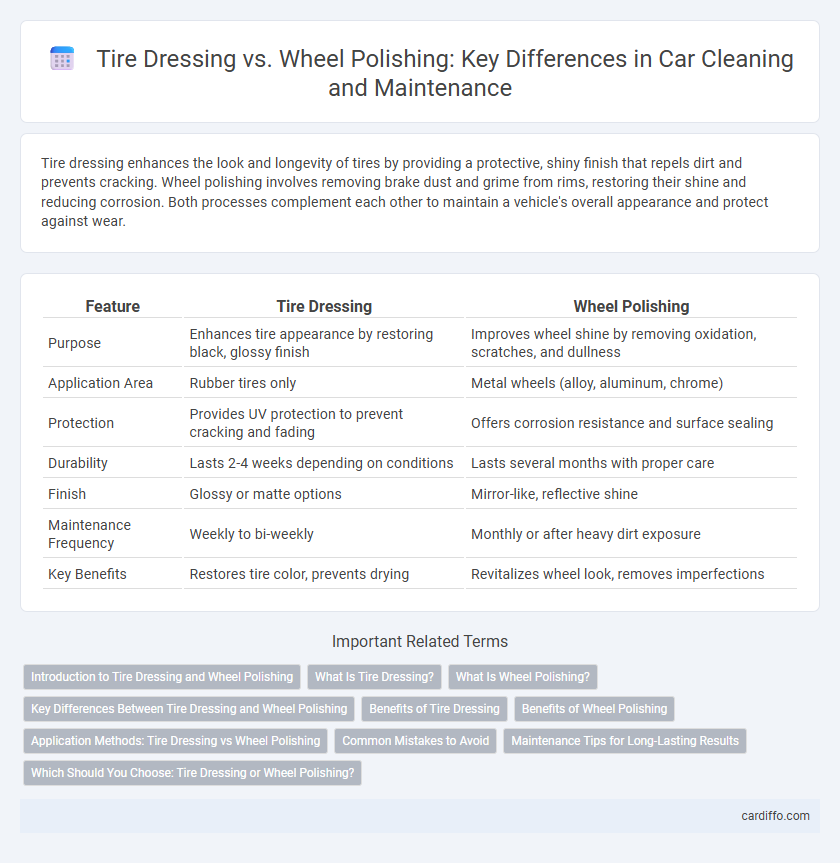Tire dressing enhances the look and longevity of tires by providing a protective, shiny finish that repels dirt and prevents cracking. Wheel polishing involves removing brake dust and grime from rims, restoring their shine and reducing corrosion. Both processes complement each other to maintain a vehicle's overall appearance and protect against wear.
Table of Comparison
| Feature | Tire Dressing | Wheel Polishing |
|---|---|---|
| Purpose | Enhances tire appearance by restoring black, glossy finish | Improves wheel shine by removing oxidation, scratches, and dullness |
| Application Area | Rubber tires only | Metal wheels (alloy, aluminum, chrome) |
| Protection | Provides UV protection to prevent cracking and fading | Offers corrosion resistance and surface sealing |
| Durability | Lasts 2-4 weeks depending on conditions | Lasts several months with proper care |
| Finish | Glossy or matte options | Mirror-like, reflective shine |
| Maintenance Frequency | Weekly to bi-weekly | Monthly or after heavy dirt exposure |
| Key Benefits | Restores tire color, prevents drying | Revitalizes wheel look, removes imperfections |
Introduction to Tire Dressing and Wheel Polishing
Tire dressing enhances the appearance and longevity of tires by providing a protective layer that restores their natural black finish and prevents cracking from UV exposure. Wheel polishing removes brake dust, grime, and oxidation from wheel surfaces, restoring shine and preventing corrosion for alloy or chrome wheels. Both processes are essential in automotive detailing to maintain the wheel area's aesthetic appeal and durability.
What Is Tire Dressing?
Tire dressing is a specialized automotive product designed to restore and enhance the appearance of tires by providing a clean, glossy finish while protecting against cracking, fading, and UV damage. Unlike wheel polishing, which focuses on removing brake dust and restoring the shine of metal alloy or chrome wheels, tire dressing specifically conditions the rubber surface to maintain its flexibility and extend tire lifespan. Using tire dressing regularly improves the vehicle's overall aesthetic and prevents premature tire wear caused by environmental exposure.
What Is Wheel Polishing?
Wheel polishing is the process of restoring a wheel's surface by removing oxidation, scratches, and imperfections using abrasive compounds or polishing machines, resulting in a smooth, reflective finish that enhances the wheel's appearance. Unlike tire dressing, which conditions and protects the rubber of tires, wheel polishing targets the metal or alloy surface to maintain and improve its shine and durability. Regular wheel polishing helps prevent corrosion and extends the life of alloy wheels while boosting curb appeal.
Key Differences Between Tire Dressing and Wheel Polishing
Tire dressing primarily enhances rubber tire surfaces by restoring their black sheen and providing protection against cracking and fading, while wheel polishing targets metal or alloy wheels to remove oxidation, brake dust, and surface imperfections for a reflective finish. Tire dressing products often contain silicone or water-based formulas to nourish and protect rubber, whereas wheel polishing involves abrasive compounds or polishing pads designed to smooth and brighten metal surfaces. Understanding these distinct purposes helps achieve optimal automotive aesthetics by using tire dressing for tire maintenance and wheel polishing for wheel restoration.
Benefits of Tire Dressing
Tire dressing enhances the appearance of tires by restoring their deep black color and providing a long-lasting shine that resists fading and cracking. It also offers protection against harmful UV rays, dirt, and harsh weather conditions, extending the tire's lifespan and maintaining its flexibility. Applying tire dressing improves overall vehicle aesthetics, contributing to a cleaner, more polished look without the need for intensive scrubbing or chemical treatments.
Benefits of Wheel Polishing
Wheel polishing enhances the appearance of wheels by removing oxidation, brake dust, and minor scratches, resulting in a smooth, reflective surface that tire dressing cannot achieve. It extends the lifespan of wheels by protecting the metal from corrosion and environmental damage, improving overall vehicle maintenance. Polished wheels contribute to vehicle resale value by maintaining a like-new finish that complements freshly detailed tires.
Application Methods: Tire Dressing vs Wheel Polishing
Tire dressing is applied using a sponge or spray applicator to evenly coat the rubber surface, enhancing protection and shine while preventing cracking and fading. Wheel polishing requires the use of soft cloths or polishing pads combined with specialized polishes or compounds to remove oxidation, brake dust, and scratches, restoring the metal's luster. Both methods demand careful, uniform application to ensure long-lasting results and maintain the vehicle's aesthetic appeal.
Common Mistakes to Avoid
Applying tire dressing on the wheel surface can cause uneven finishes and attract excessive dirt, undermining the cleaning effort. Using abrasive polishes not formulated for wheels may damage the protective coatings and lead to premature wear. Avoid spraying tire dressing on brakes or suspension components to prevent safety hazards and maintain vehicle performance.
Maintenance Tips for Long-Lasting Results
Tire dressing enhances rubber protection by preventing cracking and fading, while wheel polishing restores shine by removing brake dust and surface oxidation. For long-lasting results, apply tire dressing on clean, dry tires and allow it to cure fully before driving, and use a non-abrasive polish with a microfiber cloth for wheels to avoid scratches. Regular maintenance includes washing wheels and tires before application and reapplying tire dressing every two weeks while polishing wheels monthly to sustain optimal appearance.
Which Should You Choose: Tire Dressing or Wheel Polishing?
Tire dressing enhances the appearance and protects rubber tires by restoring their deep black shine and preventing cracking or fading caused by UV exposure and dirt. Wheel polishing focuses on removing oxidation, brake dust, and surface imperfections from metal or alloy wheels to achieve a reflective, mirror-like finish. Choose tire dressing for maintaining tire longevity and aesthetic, while wheel polishing is ideal for revitalizing and protecting the wheel's metal surfaces.
Tire Dressing vs Wheel Polishing Infographic

 cardiffo.com
cardiffo.com